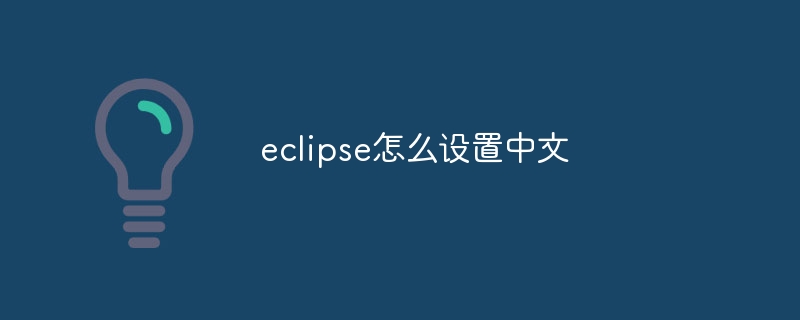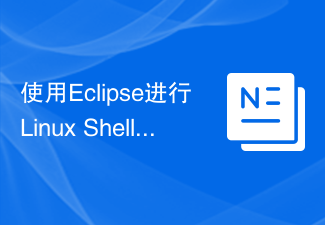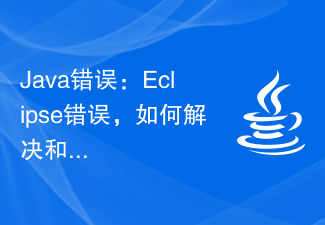
Easy to get started with Eclipse: code formatting shortcut keys revealed, specific code examples are required
Eclipse is a powerful integrated development environment (IDE), in software It is widely used in development. Whether you are a beginner or an experienced developer, proficient use of Eclipse shortcut keys can greatly improve development efficiency. Among them, the code formatting shortcut key is a very practical function that can help us maintain the standardization and readability of the code during the process of writing code. This article will reveal the commonly used code formatting shortcut keys in Eclipse and provide specific code examples to help readers better master these techniques.
In Eclipse, we can use the following shortcut keys to format code:
- Ctrl Shift F: This is the most commonly used code formatting shortcut key in Eclipse. By selecting the code and pressing this shortcut key, Eclipse will automatically format the selected code, including adjusting indentation, adding spaces, and newlines. The following is a specific example:
public class Example {
public static void main(String[] args) {
int a = 5;
if (a > 0) {
System.out.println("a is positive.");
} else {
System.out.println("a is negative or zero.");
}
}
}After selecting the above code, press the Ctrl Shift F shortcut key, and Eclipse will automatically format the code for us, adjust the indentation and add spaces, so that The code is more readable:
public class Example {
public static void main(String[] args) {
int a = 5;
if (a > 0) {
System.out.println("a is positive.");
} else {
System.out.println("a is negative or zero.");
}
}
}- Ctrl I: Use this shortcut key to indent the selected code. As shown below:
public class Example {
public static void main(String[] args) {
int a = 5;
if (a > 0) {
System.out.println("a is positive.");
} else {
System.out.println("a is negative or zero.");
}
}
}After selecting the above code, press the Ctrl I shortcut key, Eclipse will automatically indent the code to improve the readability of the code:
public class Example {
public static void main(String[] args) {
int a = 5;
if (a > 0) {
System.out.println("a is positive.");
} else {
System.out.println("a is negative or zero.");
}
}
}- Ctrl Shift O: Use this shortcut key to automatically import missing packages. For example, when writing Java code, if a certain class or method is used but the corresponding package is not imported, Eclipse will prompt for the missing package and automatically import the required package by pressing the Ctrl Shift O shortcut key. Here is an example:
public class Example {
public static void main(String[] args) {
Scanner scanner = new Scanner(System.in);
int a = scanner.nextInt();
System.out.println("You entered: " + a);
}
}In the above code, we used the Scanner class and the System.in object, but did not import the required packages. After pressing the Ctrl Shift O shortcut, Eclipse automatically imports the required packages so that the code can run properly.
Using Eclipse's code formatting shortcut keys can help us maintain the consistency and readability of the code, and make code writing and maintenance more convenient. Mastering the above commonly used shortcut keys will greatly improve our development efficiency.
In actual use, you can further optimize the Eclipse experience by customizing shortcut keys and setting code formatting rules. I hope the content of this article can help readers better understand and apply code formatting shortcut keys in Eclipse.
The above is the detailed content of Revealing the easy shortcut keys for Eclipse code formatting. For more information, please follow other related articles on the PHP Chinese website!
 使用Eclipse进行Linux Shell脚本开发的基本配置指南Jul 06, 2023 pm 05:00 PM
使用Eclipse进行Linux Shell脚本开发的基本配置指南Jul 06, 2023 pm 05:00 PM使用Eclipse进行LinuxShell脚本开发的基本配置指南在Linux环境下,Shell脚本是一种强大且常用的编程语言,用于自动化执行各种任务和管理系统。Eclipse是一款功能强大的集成开发环境(IDE),可以帮助开发人员更高效地编写、调试和管理Shell脚本。本文将介绍如何在Eclipse中配置和使用Shell脚本开发环境。第一步:安装Eclip
 eclipse如何显示行号Dec 24, 2020 am 11:03 AM
eclipse如何显示行号Dec 24, 2020 am 11:03 AMeclipse显示行号的方法:1、直接输入快捷键“CTRL+F10”,勾选“show line numbers”;2、右键点击其侧边栏,勾选“show line numbers”;3、在Eclipse菜单栏中设置显示行号即可。
 eclipse怎么设置中文Jul 24, 2023 am 11:02 AM
eclipse怎么设置中文Jul 24, 2023 am 11:02 AMeclipse设置中文方法:1、启动Eclipse,在启动界面的工具栏上点击"Preferences"按钮;2、弹出的首选项对话框中,点击"General"选项;3、在"General"选项下,点击"Appearance"子选项;4、点击"Language"选择框,选择“中文”即可设置成中文;5、关闭eclipse,重启即可使用中文。
 使用Eclipse进行Linux Shell脚本自动化的基本配置指南Jul 04, 2023 pm 06:49 PM
使用Eclipse进行Linux Shell脚本自动化的基本配置指南Jul 04, 2023 pm 06:49 PM使用Eclipse进行LinuxShell脚本自动化的基本配置指南简介:LinuxShell脚本是一种强大的自动化工具,用于在Linux操作系统中执行一系列命令和操作。Eclipse是一种流行的集成开发环境(IDE),主要用于Java开发,但也可以用于编辑和执行Shell脚本。本文将介绍如何在Eclipse中配置和使用Shell脚本的自动化工具。安装Ec
 eclipse创建springboot项目的方式有哪些May 22, 2023 pm 07:19 PM
eclipse创建springboot项目的方式有哪些May 22, 2023 pm 07:19 PM方法一安装STS插件安装插件导向窗口完成后,在eclipse右下角将会出现安装插件的进度,等插件安装完成后重启eclipse生效新建springboot项目项目启动方法二1.创建Maven项目2.选择项目类型3.选择项目4.编写项目组和名称-finish即可5.修改pom.xml文件org.springframework.bootspring-boot-starter-parent2.0.2.RELEASE6.pom.xml中添加依赖org.springframework.bootspring-
 eclipse左侧项目栏不见了怎么解决Feb 19, 2021 pm 05:14 PM
eclipse左侧项目栏不见了怎么解决Feb 19, 2021 pm 05:14 PM解决方法:首先打开eclipse软件,点击顶部导航栏中的“window”选项;然后在打开的下拉菜单中,点击“show view”选项;接着在打开的菜单中,点击“project Exlorer”选项即可调出左侧项目栏。
 Java错误:Eclipse错误,如何解决和避免Jun 25, 2023 am 09:09 AM
Java错误:Eclipse错误,如何解决和避免Jun 25, 2023 am 09:09 AMJava作为一种非常强大和流行的编程语言,被广泛应用于各种计算机应用和开发领域。在编写Java代码时,经常会遇到各种错误信息,这些错误信息可能会影响代码的正常编译和运行。其中,Eclipse是一种广泛使用的集成开发环境,而在Eclipse中遇到错误也是相当常见的。本文将探讨一些常见的Eclipse错误,并提供解决和避免这些错误的方法。一、常见的Eclipse
 怎么将eclipse语言设置为中文Jan 04, 2023 pm 03:50 PM
怎么将eclipse语言设置为中文Jan 04, 2023 pm 03:50 PMeclipse语言设置为中文的方法:1、打开浏览器找到语言包下载地址,并将最新的安装包地址复制;2、打开eclipse,点击“help”,然后点击安装新的插件;3、点击“Add”,在Location中粘帖网址;4、在下拉菜单中找到简体中文包,进行勾选,点击Next等待安装;5、重启eclipse即可。


Hot AI Tools

Undresser.AI Undress
AI-powered app for creating realistic nude photos

AI Clothes Remover
Online AI tool for removing clothes from photos.

Undress AI Tool
Undress images for free

Clothoff.io
AI clothes remover

AI Hentai Generator
Generate AI Hentai for free.

Hot Article

Hot Tools

Zend Studio 13.0.1
Powerful PHP integrated development environment

EditPlus Chinese cracked version
Small size, syntax highlighting, does not support code prompt function

Dreamweaver Mac version
Visual web development tools

Atom editor mac version download
The most popular open source editor

mPDF
mPDF is a PHP library that can generate PDF files from UTF-8 encoded HTML. The original author, Ian Back, wrote mPDF to output PDF files "on the fly" from his website and handle different languages. It is slower than original scripts like HTML2FPDF and produces larger files when using Unicode fonts, but supports CSS styles etc. and has a lot of enhancements. Supports almost all languages, including RTL (Arabic and Hebrew) and CJK (Chinese, Japanese and Korean). Supports nested block-level elements (such as P, DIV),






